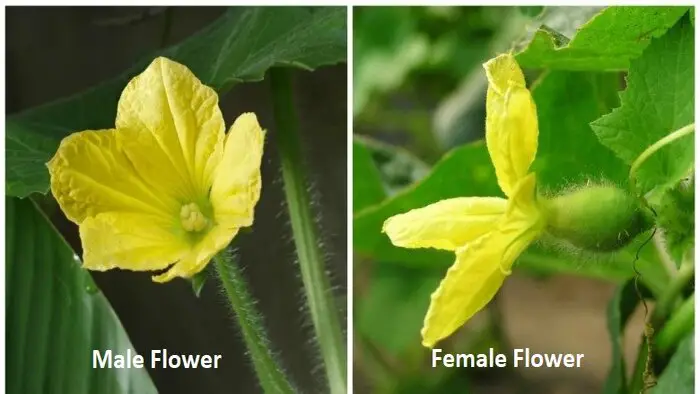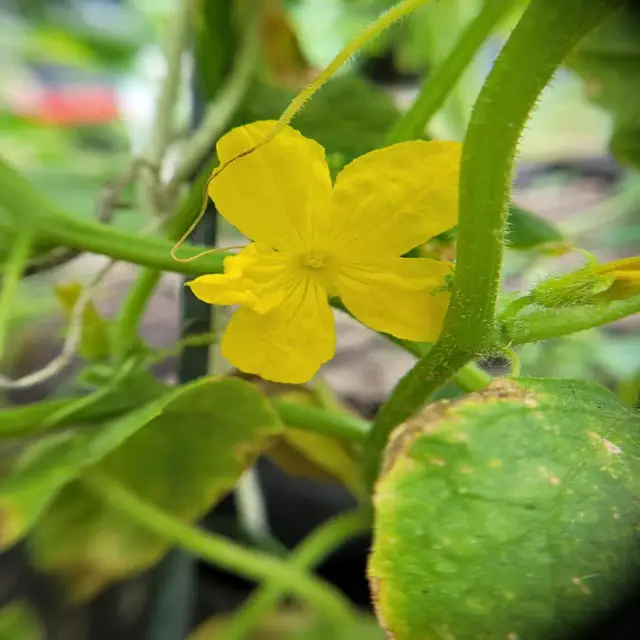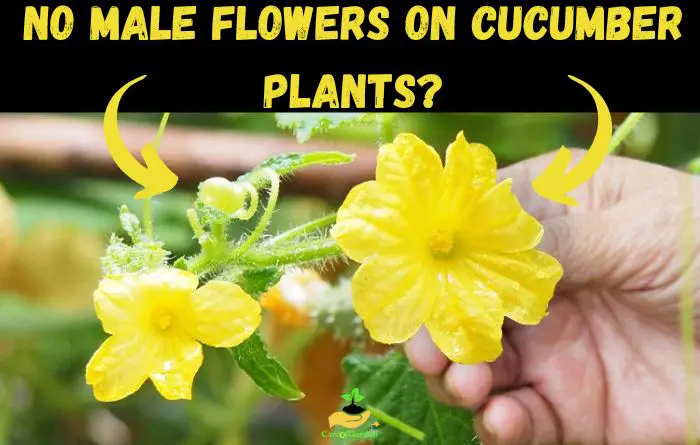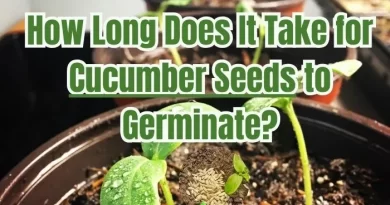No Male Flowers on Cucumber Plants? (Here is Why)
As someone who has grown cucumbers before, I understand how frustrating it can be to see a plant with no male flowers, especially when I need to pollinate my female flowers to produce fruits. In this article, I aim to explore the reasons why cucumber plants may not produce male flowers.
If your cucumber plants are not producing male flowers, it could be due to factors such as extreme temperatures, over-fertilization with nitrogen, or genetic factors. To address this issue, it’s important to provide optimal growing conditions by ensuring well-draining soil, adequate sunlight, and regular watering. You may also consider hand pollination or choosing a different variety of cucumber that produces more male flowers.
Causes of No Male Flowers on Cucumber Plants
1. Over-fertilization with Nitrogen
An excess of nitrogen can lead to a deficiency in male flowers within cucumber plants. While nitrogen is undoubtedly vital for the growth and development of plants, it also has the power to encourage cucumber vegetative growth, which comes at the expense of flower and fruit production.
To be more specific, an excess of nitrogen causes plants to prioritize the growth of leaves and stems over flowers and fruits. Consequently, this can lead to a decrease in flower production and a scarcity of flowers, which are crucial for pollination and subsequent fruit development.
As if this weren’t enough, excessive vegetative growth resulting from nitrogen excess actually weakens the cucumber plant’s defenses against stress and disease further diminishing flower production.
Solution
To prevent a shortage of male flowers caused by nitrogen levels, it is important to avoid over-fertilizing cucumber plants with nitrogen-rich fertilizers.
Instead, consider using fertilizers or compost that provide an amount of nitrogen along, with other essential nutrients.
| Cucumber Growth Stage | Nitrogen Requirement |
|---|---|
| Seedling | 20-30 lbs/acre |
| Vegetative | 50-75 lbs/acre |
| Flowering | 75-100 lbs/acre |
| Fruiting | 100-125 lbs/acre |
It is also vital to ensure draining soil as excess nitrogen can lead to waterlogged soil and root rot, which further diminishes flower production.
2. Temperatures Fluctuations
Sudden temperature fluctuations, such as warm days followed by cold nights, can disrupt the flowering schedule of cucumber plants. This can lead to delayed flowering, including the production of male flowers. Delayed flowering reduces the window for successful pollination and fruit set.
These crops are sensitive to temperature changes and extreme heat or cold negatively impacts flower development. High temperatures may lead to a higher proportion of female flowers compared to males or even halt flower production altogether.
Conversely, when temperatures drop too low, there might be no development of male flowers at all. Rainy weather can also affect pollination, which can result in a shortage of male flowers. It’s crucial to maintain growing conditions to ensure a good yield of male flowers.
The ideal temperature range, for cucumber plants lies between 70 and 85 degrees Fahrenheit ((21 and 29 degrees Celsius). Consistently deviating from this range can result in cucumbers not producing male flowers and also reduced fruit production.
Solution
To ensure that your cucumber plants are not adversely affected by temperature fluctuations it is crucial to give them sufficient shade and/or ventilation when the weather is hot and shield them from frost or sudden cold spells when it gets cooler.
3. Overwatering and Underwatering
Excessive watering of cucumber plants can result in a decrease in the number of male flowers. When you overwater your cucumbers, their roots can become saturated and deprived of oxygen, which causes stress and nutrient deficiencies. This can cause cucumbers to prioritize survival instead of reproduction resulting in fewer flowers and a scarcity of male flowers.
Overwatering can also create conditions for fungal diseases like powdery mildew to develop, further stressing the plant and reducing flower production.
Excessive watering will also contribute to root rot a condition caused by fungi that attack the cucumber root system. When root rot damages the roots it impairs their ability to absorb water and nutrients resulting in poor health and diminished flowering capacity.
Solution
To prevent overwatering, it is important to water cucumber plants deeply but infrequently, allowing the soil to dry out slightly between waterings. Additionally, ensuring that the soil has drainage and avoiding stagnant water, around the plants is crucial.
Underwatering
Insufficient watering can also cause a deficiency of male flowers in cucumber plants. When plants do not receive water, the soil becomes excessively dry depriving the plant of sufficient water to facilitate flower formation.
In the end, your cucumbers will prioritize survival over reproduction, resulting in decreased flower production and a scarcity of flowers.
As I find out, if it doesn’t get water, your cucumbers may struggle to effectively transport their’s necessary nutrients and hormones. As a result, this can lead to a decrease in flower production and the absence of male flowers.
Furthermore, when there isn’t water the plant’s overall strength weakens, making it more vulnerable, to stress and diseases. These factors combined can further diminish the plants ability to produce flowers.
Solution
To prevent underwatering, it is crucial to ensure regular watering of cucumber plants, especially during hot weather conditions or periods of drought.
4. Not Receiving Enough Sunlight
The fourth reason why cucumber plants lack male flowers is quite obvious. Sunlight plays a huge role in the growth and development of your cucumber plants.
When cucumber plants do not receive sunlight, they may fail to produce growth hormones to stimulate flower growth. As a result, there may be a shortage of flowers.
Furthermore, insufficient sunlight weakens the plant making it more susceptible, to stress and diseases which ultimately leads to cucumbers not producing male flowers.
Solution
To prevent a shortage of male flowers caused by insufficient sunlight it’s crucial to ensure that cucumber plants are placed in a sunny area with at least 6 8 hours of direct sunlight daily.
If your cucumber plants aren’t getting sunlight you may want to consider relocating them to a sunnier spot or using grow lights as an additional light source.
5. Gynoecious Variety (Genetics)

Another reason I know that could cause cucumbers to not have male flowers is due to genetics. Cucumber plants naturally have both male and female flowers, but the ratio of males to females can vary depending on the genetic makeup of the plant.
There are some cucumber varieties that produce only male flowers and are called androecious and other cucumber varieties that produce only female flowers are called gynoecious.
| Cucumber Variety | Floral Type |
|---|---|
| Straight Eight | Androecious |
| Marketmore 76 | Androecious |
| National Pickling | Androecious |
| Armenian | Androecious |
| Poinsett 76 | Androecious |
| Diva | Gynoecious |
| Sweet Success | Gynoecious |
| Tasty Green | Gynoecious |
| Fanfare | Gynoecious |
| Saladmore Bush | Gynoecious |
https://www.johnnyseeds.com/growers-library/vegetables/cucumbers/cucumbers-greenhouse-varieties-comparison-chart-pdf.html
https://www.burpee.com/vegetables/cucumbers/
If you’re growing a specific type of cucumber that predominantly produces female flowers and you notice a lack of male flowers, it’s crucial to ensure that you have planted enough plants that produce both male and female flowers.
Most seed companies offer cucumber seed blends with a majority (85% to 90%) of seeds for the female flower variety and a smaller portion (10% to 15%) for the male-female flower variety. This blend will help guarantee sufficient pollination.
Solution
Moreover, you might want to consider manually pollinating the flowers using a cotton swab or soft paintbrush. This method can aid in fruit production, especially when there are limited male flowers available.
If you suspect that genetic factors are causing the absence of male flowers in your cucumber plants, you might consider selecting a different variety or seeking advice from a plant geneticist or horticulturist for further guidance.
6. Not Mature Enough to Produce Flowers
Finally, it is possible that the cucumber plant is not mature enough to produce male flowers. Cucumber plants generally start producing male flowers before female flowers, so if you are seeing only female flowers, it could be that the plant is not yet mature enough to produce male flowers.
In this case, it is important to be patient and wait for your cucumbers to mature.
How to encourage male flower growth on cucumber plants

There are several solutions for cucumber plants with no male flowers, depending on the underlying cause.
Proper Plant Care
To ensure that cucumber plants produce male flowers, proper plant care is essential. This includes providing adequate water and nutrients to the plant. Cucumber plants require well-drained soil with a pH between 6.0 and 6.8.
They also need regular fertilization with a balanced fertilizer that contains nitrogen, phosphorus, and potassium. A lack of phosphorous in the soil can lead to a lack of male flowers, so it is important to ensure that the soil is rich in this nutrient.
Use of Fertilizers
To promote the growth of male flowers, it is important to use the right type of fertilizer. A balanced fertilizer that contains nitrogen, phosphorus, and potassium can help to promote the growth of male flowers.
It is important to avoid over-fertilization, as this can lead to an excess of foliage growth and a lack of male flowers.
Choose the right variety
Some varieties of cucumber plants are bred to produce predominantly female flowers, while others produce more male flowers. If you’re experiencing a lack of male flowers, you may want to try a different variety of cucumber that is known to produce more male flowers.
Hand Pollination
If bee activity is low or absent, hand pollination can be an effective way to ensure that cucumber plants produce male flowers. This involves transferring pollen from the male flowers to the female flowers using a small paintbrush.
To do this, wait until the male flowers are fully open and then gently brush the inside of the flower with the paintbrush. Then, transfer the pollen to the female flowers.
Be Patient
In addition to the above solutions, it is important to be patient and wait for the male flowers to appear. It can take several weeks for male flowers to develop, so it is important to be patient and not panic if they do not appear immediately.
It is also important to avoid using insecticides that can harm beneficial insects such as bees, which are essential for pollination. By following these solutions, gardeners can ensure that their cucumber plants produce an adequate number of male flowers and avoid a lack of pollination.
Conclusion
In conclusion, we have explored the potential reasons why cucumber plants may not produce male flowers, including extreme temperatures, over-fertilization with nitrogen, and genetic factors.
If you’ve experienced a lack of male flowers on your cucumber plants, we encourage you to share your own experiences and insights.
Male flowers are important for cucumber plants because they produce pollen, which is necessary for pollination and fruit production.
Yes, hand pollination can be used to address a lack of male flowers on cucumber plants. This involves manually transferring pollen from male flowers to female flowers using a small brush or cotton swab.
No, a cucumber plant requires male flowers for pollination in order to produce fruit. Without male flowers, the plant will not be able to produce cucumbers.




